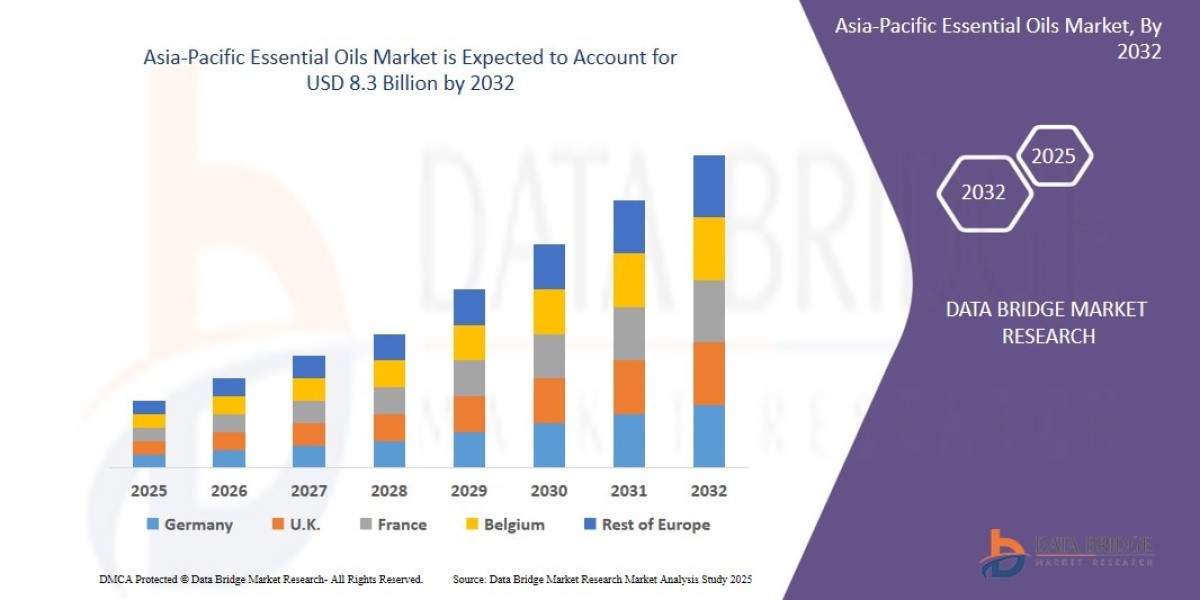Introduction
The Asia-Pacific essential oils market has become one of the most dynamic and rapidly expanding segments of the global natural products industry. Essential oils, derived from aromatic plants through distillation or extraction, are widely used across sectors such as food and beverages, cosmetics, personal care, aromatherapy, and pharmaceuticals. Their natural origins, therapeutic benefits, and versatile applications make them highly valuable in today’s health-conscious and sustainability-driven economy.
The Asia-Pacific region, with its rich biodiversity, agricultural capacity, and centuries-old tradition of using plant-based remedies, has emerged as both a major producer and consumer of essential oils. Rising disposable incomes, growing awareness of wellness, and the increasing demand for clean-label and natural products are further boosting consumption.
This report provides a detailed analysis of the Asia-Pacific essential oils market, exploring its current landscape, growth drivers, challenges, segmentation, and competitive environment. It also highlights future trends and opportunities, offering a holistic view for stakeholders ranging from manufacturers and distributors to investors and policymakers.
Source - https://www.databridgemarketresearch.com/reports/asia-pacific-essential-oils-market
Market Overview
The Asia-Pacific essential oils market encompasses the production, distribution, and consumption of oils derived from plants such as lavender, peppermint, eucalyptus, tea tree, lemongrass, and citrus fruits. These oils serve a wide range of purposes, from flavoring and fragrance to therapeutic and medicinal use. The region’s diverse climate and agricultural resources make it one of the most significant global hubs for essential oil production.
Historically, essential oils have played an important role in Asian cultures, particularly in traditional medicine systems such as Ayurveda, Traditional Chinese Medicine (TCM), and herbal healing practices across Southeast Asia. Over the past few decades, this traditional use has evolved into a robust commercial market, fueled by global demand for natural products.
The current market landscape is characterized by strong growth momentum. The rising popularity of aromatherapy, the boom in natural skincare, and the food industry’s increasing reliance on natural flavors have accelerated consumption. While countries like India, China, and Indonesia dominate production, demand is equally strong across developed markets such as Japan, South Korea, and Australia. Essential oils are increasingly recognized not just as wellness products but also as high-value commodities in the global trade of natural ingredients.
Market Drivers and Opportunities
Several key factors are driving the growth of the Asia-Pacific essential oils market.
One major driver is the rising demand for natural and organic products. As consumers shift away from synthetic chemicals in food, cosmetics, and household products, essential oils are gaining traction as safe and natural alternatives. This is particularly evident in the cosmetics and personal care industry, where oils like tea tree, lavender, and rose have become central to natural skincare and haircare formulations.
The expanding wellness and aromatherapy trend also supports market growth. Aromatherapy has gained mainstream popularity across Asia-Pacific, particularly in urban centers where stress management and holistic health practices are in high demand. Spas, wellness retreats, and even workplaces are adopting essential oils for relaxation and therapeutic purposes.
Opportunities also lie in the food and beverage sector, where essential oils are increasingly used as natural flavoring agents and preservatives. Oils such as peppermint, citrus, and basil are being incorporated into confectionery, beverages, and functional foods.
From an investment perspective, technological advancements in extraction methods, such as supercritical CO₂ extraction, are improving yield and oil purity, creating opportunities for premium product lines. Additionally, the growing popularity of e-commerce platforms in Asia-Pacific is opening new distribution channels, allowing small and medium enterprises to reach a wider consumer base.
Market Challenges and Restraints
Despite its promising trajectory, the Asia-Pacific essential oils market faces several challenges.
One key issue is the fluctuation in raw material availability. Essential oil production depends heavily on agricultural crops, which are vulnerable to climate change, pests, and unpredictable weather patterns. Such variability can impact supply and pricing.
Quality control and standardization also present challenges. Due to the fragmented nature of the market, issues such as adulteration and inconsistent quality are common, which can erode consumer trust and affect export competitiveness.
Regulatory hurdles further complicate the landscape. Different countries in the region impose varying standards on labeling, safety, and permissible applications of essential oils. For example, while some oils are approved as food additives in certain markets, they may be restricted to cosmetic use in others.
Additionally, competition from synthetic substitutes and alternative natural products could limit growth in some applications. Synthetic fragrance compounds, although less preferred by health-conscious consumers, often offer cost advantages to manufacturers.
Market Segmentation Analysis
The Asia-Pacific essential oils market can be segmented by product type, end-use application, distribution channel, and regional insights.
By product type, citrus oils account for a significant share, driven by their widespread use in beverages, confectionery, and household cleaning products. Tea tree oil, primarily produced in Australia, is another key segment due to its strong antibacterial properties and popularity in skincare. Lavender, peppermint, eucalyptus, and lemongrass oils are also widely demanded for personal care, aromatherapy, and household use.
By end-user application, the cosmetics and personal care industry dominates the market, with essential oils being central to natural skincare, haircare, and fragrance products. The food and beverage sector represents another major segment, as natural flavoring agents and preservatives become increasingly popular. Aromatherapy and wellness applications are rapidly growing, particularly in urban markets. Pharmaceuticals and industrial uses, though smaller in share, are expanding steadily as research highlights the therapeutic benefits of essential oils.
In terms of distribution, offline channels such as supermarkets, specialty stores, and pharmacies remain strong, especially in emerging markets. However, online platforms are growing rapidly, offering consumers convenient access to a wide range of products, including organic and artisanal oils.
Regionally, India, China, and Indonesia dominate production due to their agricultural capacity and export orientation. Australia is notable for tea tree and eucalyptus oils, while Japan and South Korea lead in high-value consumption of essential oils in cosmetics and wellness products. Southeast Asian countries like Vietnam and Thailand are emerging as important players, leveraging both traditional knowledge and export opportunities.
Competitive Landscape
The Asia-Pacific essential oils market is highly competitive and fragmented, with a mix of multinational corporations, regional producers, and small-scale distillers. Large companies often benefit from integrated supply chains, strong branding, and wide distribution networks, while smaller players focus on organic, artisanal, or locally sourced products.
Strategic mergers, acquisitions, and partnerships are common in this sector, as companies seek to expand market presence and secure raw material sources. Collaborations with cosmetics, food, and wellness brands are particularly prominent, ensuring steady demand and innovative product development.
Innovation remains a key competitive strategy. Leading players are investing in advanced extraction technologies, sustainable sourcing practices, and product diversification to meet consumer expectations. For example, companies are introducing organic-certified oils, eco-friendly packaging, and blends designed for specific applications like stress relief or immune support.
Brand differentiation through transparency and traceability is also becoming critical. Consumers increasingly demand information about sourcing, production methods, and certifications, pushing companies to adopt blockchain-based tracking and third-party certifications to build trust.
Future Outlook and Trends
The future of the Asia-Pacific essential oils market looks promising, with growth expected to accelerate over the next decade. Sustainability will be a defining theme, with companies adopting eco-friendly farming and extraction practices to address environmental concerns and appeal to conscious consumers.
Consumer trends will continue to shift toward wellness, holistic health, and natural products. The demand for aromatherapy and spa treatments will expand beyond urban centers, reaching new demographics as disposable incomes rise. Similarly, the food and beverage industry is expected to increase its reliance on essential oils as natural flavoring and preservative agents.
Technological innovation will play an important role, from precision farming and AI-driven supply chain optimization to new extraction methods that maximize yield and purity. E-commerce will remain a dominant growth channel, offering brands a direct route to consumers while fostering niche and premium product categories.
Regionally, India and China will remain production powerhouses, while Japan, South Korea, and Australia will drive high-value consumption. Southeast Asia will emerge as both a production and consumption hub, supported by rising wellness tourism and growing exports.
Conclusion
The Asia-Pacific essential oils market stands at the intersection of tradition and modernity, leveraging centuries of plant-based healing practices alongside advanced technologies and global consumer trends. With applications spanning cosmetics, food, wellness, and pharmaceuticals, essential oils have firmly established themselves as high-value commodities in the regional economy.
While challenges such as supply chain disruptions, regulatory complexities, and quality issues persist, the market’s adaptability and focus on sustainability position it for long-term success. For businesses and investors, the sector offers vast opportunities to innovate, differentiate, and expand into new applications and regions.
Looking forward, the Asia-Pacific essential oils market is expected to continue its strong growth trajectory, shaping the future of natural products and wellness on both regional and global scales.
Frequently Asked Questions
What is the current size of the Asia-Pacific essential oils market?
The market is experiencing steady growth, driven by rising demand from cosmetics, food, wellness, and aromatherapy sectors. While exact figures vary, the Asia-Pacific region represents one of the largest and fastest-growing markets globally.
What are the key drivers influencing growth in this market?
Major drivers include increasing consumer preference for natural and organic products, the expansion of the wellness and aromatherapy industry, and rising use of essential oils in food, beverages, and pharmaceuticals.
Which regions dominate the Asia-Pacific essential oils market?
India, China, and Indonesia dominate production due to their agricultural resources, while countries like Japan, South Korea, and Australia lead in high-value consumption. Southeast Asian nations are emerging as key growth markets.
Who are the major players in the industry?
The market includes a mix of multinational companies, regional producers, and artisanal distillers. Leading firms differentiate themselves through innovation, sustainability, and strong distribution networks.
What are the latest trends shaping the future of this market?
Trends include sustainable sourcing, advanced extraction technologies, personalized blends, eco-friendly packaging, and the rise of e-commerce as a key distribution channel.
What challenges could slow down growth in this sector?
Challenges include raw material supply fluctuations, quality control issues, regulatory differences across markets, and competition from synthetic alternatives.
How can businesses benefit from investing in the Asia-Pacific essential oils market?
Businesses can benefit by focusing on sustainable practices, offering organic-certified products, leveraging e-commerce platforms, and exploring niche applications such as nutraceuticals and wellness tourism.
Browse More Reports:
Global Urticaria Market
Global UV Adhesive Market
Global Varicose Vein Treatment Market
Global Veneer Sheets Market
Global Windows and Doors Market
Europe Alcoholic Beverages Market
Asia-Pacific Alopecia Treatment (Hair Loss) Market
Middle East and Africa Alopecia Treatment (Hair Loss) Market
Thailand Business Process Outsourcing (BPO) Market
Europe Corrugated Board Packaging Market
Asia-Pacific Essential Oils Market
U.S. Fleet Management Market
North America Fleet Management Market
Middle East and Africa Helium-3 Market
Europe Hemodialysis and Peritoneal Dialysis Market
Europe Industrial Metrology Market
Middle East and Africa Industrial Metrology Market
Europe Insect Protein Market
Asia-Pacific Insect Protein Market
Middle East and Africa Insect Protein Market
About Data Bridge Market Research:
An absolute way to forecast what the future holds is to comprehend the trend today!
Data Bridge Market Research set forth itself as an unconventional and neoteric market research and consulting firm with an unparalleled level of resilience and integrated approaches. We are determined to unearth the best market opportunities and foster efficient information for your business to thrive in the market. Data Bridge endeavors to provide appropriate solutions to the complex business challenges and initiates an effortless decision-making process. Data Bridge is an aftermath of sheer wisdom and experience which was formulated and framed in the year 2015 in Pune.
Contact Us:
Data Bridge Market Research
US: +1 614 591 3140
UK: +44 845 154 9652
APAC : +653 1251 975
Email:- corporatesales@databridgemarketresearch.com








